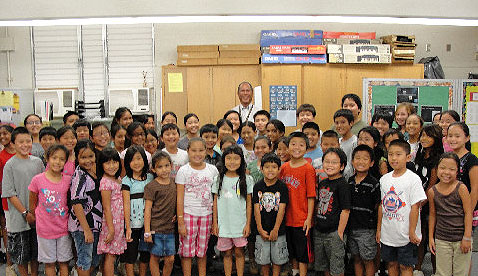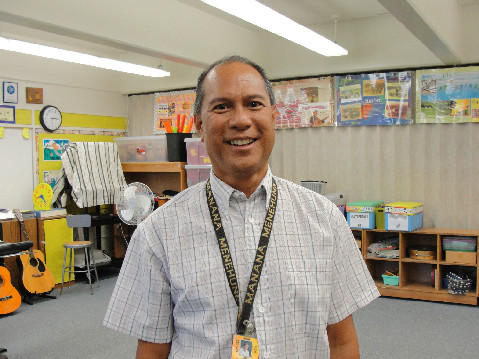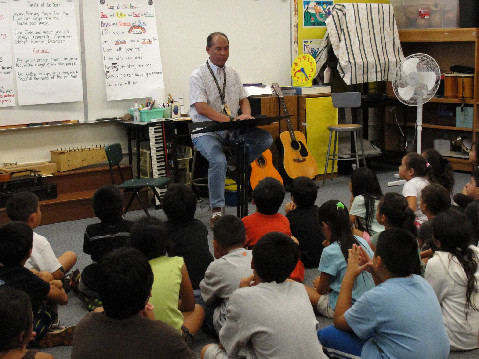
Manana Elementary School in Pearl City has a very special group of students that just love to sing. They have a Music Director, Mr. Aaron Paragoso that just loves to teach. Na Keiki O’ Manana is the school’s choral signing group made up of students in grades 3, 4, 5 and 6. They are well known for their exceptional performances that have inspired audiences throughout the state as well as on the mainland.
Mr. Paragoso has led Manana Keiki O’ Manana for the past 16 years as well as served as the school’s music teacher. His experience as a performer has taken him on stage with stars like Jim Nabors and currently sings with the Hawaii Vocal Arts Ensemble. Staying active as a performer keeps him sharp and on top of his game. It show in his students. Their professionalism is impressive.
The 2009-2010 Na Keiki O’ Manana Chorus faces its challenges this school year. The current economy has affected the group. They basically survive “financially” on fundraising efforts led by dedicated Parents who coordinate fund raising activities. This is a strong group of volunteers who are instrumental in the success of the chorus.
Manana Elementary School Administration and staff also play an integral role in supporting the program.
 Mr. Aaron Paragoso | Photo by Barry Villamil
Mr. Aaron Paragoso | Photo by Barry Villamil
Year after year, the Manana choir truly amazes all who come in contact with their voices and spirit. Mr. Paragoso explains that it comes from their hearts. “Sing with your heart.” I have to say that it truly shows. I spent an hour with the choir the other day during their first day of rehearsals and left there with chicken skin.
Through it all, the kids show up to Mr.Paragoso’s music classroom to learn how to be the best. The best that they can be at making people smile and feel good through the beauty of song. Their voices blend music and harmony for all to enjoy.
Q: You are entering your sixteenth year at Manana Elementary School. What first brought you to teach at the school?
A: “One of my students, who is now a teacher at Makakilo Mauka Lani, was in the third grade and I’ve had this child since she was 4 years old. She said, “Mr. P, we don’t have a music teacher.” I inquired, “what kind of stuff do you do? Well, she told her mother that I had asked about it and her mother called the Principal at the time. She called me, we did this phone interview, she did all the paperwork and the first day on the job here was the first day I met this Principal.”
 Mr. Paragoso leading first day of choir practice | Photo by Barry Villamil
Mr. Paragoso leading first day of choir practice | Photo by Barry Villamil
Q: How has the school changed through the years?
A: “I think the thing that’s changed is the State curriculum. That’s really changed because of the NCLB, No Child Left Behind has really dictated what happens in the schools. When I came here in 1994, I taught music all day. All day from beginning to end. When NCLB came and the kids starting taking these standardized tests and we weren’t making the scores because of the high proficiency rate that the Feds had passed down to the states, business as usual was not the same. Things really, really changed. That’s when you saw a lot of schools get rid of Art, Music, PE in favor of Language Arts and Math.”
Q: How did the change in curriculum reduce time spent teaching music?
A: “I used to teach a class 50 minutes once a week and my first graders and Kindergarten came as a grade level. The lower school would have 2 hours of music. When all this came down we got cut down to 30 minutes once a week. Now it’s back up to 45. So that has really, really changed.”
Q: Did your classroom size get reduced as well?
A: “I used to have 2 rooms together. That really allowed me to do things like Piano keyboarding with the 6th graders so I had tons of room. We were going through this growing period where they needed more room. I got switched to this one room here and it’s been fine. You work with what you have.”
Q: When did the Manana Elementary School Choir, Na Keiki O’ Manana first start at the school?
A: “The choir actually started out with Mrs. Robinson almost 30 years ago. It started out as a gifted talent program but it’s more inclusive now. Kids still have to make the grade. They still have to keep up with the work. The choir has been in existence for a long time and it was really hard shoes to fill because she was very well known in the area. She set very high standards for the choir. Luckily when I got hired I met with her several times and we really hit it off. She became like my mentor the next few years and helped me along with the choir. Hopefully I’ve continued that, I mean that’s the excellence and the musicianship and experiences that the kids have because really no other school has that kind of choral program we have where it’s so extensive. At Christmas time, we have in past years as many as 21 performances in 3 weeks.”
Q: How has the current curriculum that focuses on Language Arts and Math affected time spent working with the choir students?
A: “Now with the way things have been, with the kind of school work the kids have to do, it’s really cut back.”
Q: What is the weekly practice schedule structure?
A: “We practice three times a week. Tuesday, Wednesday and Thursday’s after school. On Tuesday’s and Thursday’s we rehearse for an hour and on Wednesday’s an hour and a half.”
Q: How many choir members do you have for the 2009-2010 school year?
A: “Right now I have just under 60 kids.”
Q: What is your selection process?
A: “They’re based on auditions. They come in and sign for me. I take a look at the overall child. How they are in school. Do they do their work? I also talk to the teachers. It’s an audition process but they don’t have to be all talented singers because it’s how you work with the child. Kids love to sing so you develop them.”
Q: Are there any challenges getting the kids to and from performances?
A: “We have to rent buses and the challenge now is the costs, its big bucks to rent buses. What we’ve done in the past is because buses are so expensive, we take them out and do two performances back to back. We usually have honorariums from different places but because the economy is so bad, it’s not happening anymore. We have to fund raise for bus fare. Our PTA has been very good to us. Our Principal has been very good to us. I have tremendous amount of support from staff and the administration.”
Q: How about uniform costs?
A: “They pay for it themselves or the mothers make them. We have a lot of children who donate their international costumes back to the organization and we have a lot of those kind of hand me downs. It works out really, really well.”
Q: How often does the choir travel to perform on the neighbor islands as well as outside the state?
A: “I believe, if I’m not mistaken, we are the only school that takes a yearly trip either to the outer islands and every 4 years to the mainland. This year will probably be the first year that we’re not though because of costs factors.”
Q: How do you cover the costs?
A: “We do a lot of fundraising.”
Q: Do you have any problems filling up your choir each year?
A: “We keep it at 60 because that’s how much can fit on a bus. You don’t want to have to rent more buses.”
Q: If you could afford to rent additional buses and increase the choir size, how big would you go?
A: “I would just open it up to as many kids as you want to because there is a lot of kids that want to be in it. The 60 is not an arbitrary number. The 60 is from the previous course teacher, she said just don’t put more than 60 because that’s how many can fit on a bus. The bus companies are strict. Sometimes you cannot fit 3 to a seat. They gotta be 2 to a seat. We also travel with all our gear. The kids have to carry all the gear.”
Q: What does your performance schedule look like for this year?
A: “It hasn’t been finalized yet, we are still working on it, but I think we are going to shoot for about 12 performances. Because it takes a toll on my parent volunteers as well as myself and it impacts the kids study habits, we try to do every other day. So we’ll do like Monday, Wednesday, Friday and sometimes a weekend performance.”
Q: Is your schedule just for the school year?
A: “Yes, just during the school year. The Winter tour, our Christmas program we’re shooting for about 12 performances and then the Parade is considered one too.”
Q: Tell us about the choir’s participation in the Christmas Parade?
A: “This will only be our third or fourth year. It was a parent that asked me, “why don’t we do the parade? It’s good for the community to see us.” I thought you know what; it’s going to be a good idea because it’s a different kind of performing, and it’s a different venue. Part of my job is to provide different kind of experiences for the kids. I thought ok, what a good idea, we enjoyed it so much that it’s something we would like to continue. We had a lot of fun.”
Q: Has your experience as a professional entertainer benefited the kids?
A: “It has really worked out well because all of the years of performing, that professional being on stage, has helped with the kids. That’s one of the first things people say about the kids, they look really professional. You know that’s a lot of discipline, a lot of structure.”
Q: Do you see your new Choir students grow as the school year goes on?
A: “It’s funny because with some kids, you don’t think they will be good performers. But then, that very first performance they just light up and your like wow! Even parents and teachers are really surprised because some kids really shine on stage. They’re so quiet in school, but they shine on stage. They love it.”
Q: What’s the biggest choir performance to date?
A: “The National Educator’s Association (NEA) has regional conferences every year. Three years ago the NEA came to Hawaii and I am very involved in the HSTA, I’m an advocate for teachers and students in that venue as well. We were approached by Roger Takabayashi, the President to perform because he knows the school and he knows the reputation the school has. I guess there were about 1200 teachers from the Pacific Region: Alaska, Washington, California, Oregon, Utah, Nevada and Hawaii. That was probably one of biggest performances; most important performances for me to have my children perform before my colleagues.”
Q: Was there an overwhelming response from the audience?
A: “They had an overwhelming standing ovation. The kids were just thrilled. They sang at the Hilton Hawaiian Village, the Coral Ballroom. That was just absolutely tremendous.”
Q: How about performances on the mainland?
A: “I used to take them to Disneyland. We sang at the Carnation Plaza. We kind of stopped doing that. It sounds wonderful to sing at Disneyland and it is, it’s a wonderful experience, but you pay for the privilege. You have to audition and you pay for the privilege. So you pay to get in, and you pay to have to take the workshops. We have been very fortunate because we’ve established a relationship but I would rather put my energies in to our kids performing for other public school kids. That’s my mission. One of my missions is to show other public schools the kind of program they can have.”
Q: How special is it being a Teacher at Manana Elementary School?
A: “I just love this school. The staff is great. I just have so much support. The kids are really good. I like the size of the school. It’s not too big, it’s just right. I still know every child. I see them from Kindergarten, well now, RSK all the way through 6th grade. I’m one of the very few teachers that can establish that relationship through the years and that’s probably one of the most rewarding aspects of teaching here.
I just get the biggest charge out of that and when I see the kids come back, just to see how they are doing. You know a lot of kids come back and visit and that to me speaks a lot because that means they have pretty good memories here at Manana.”